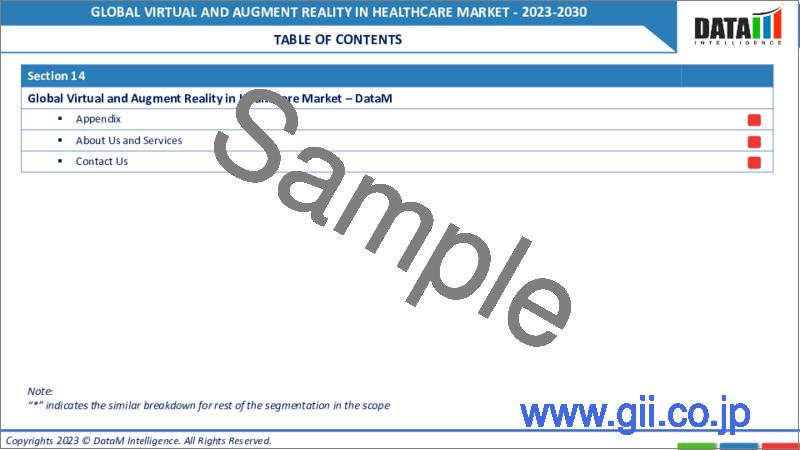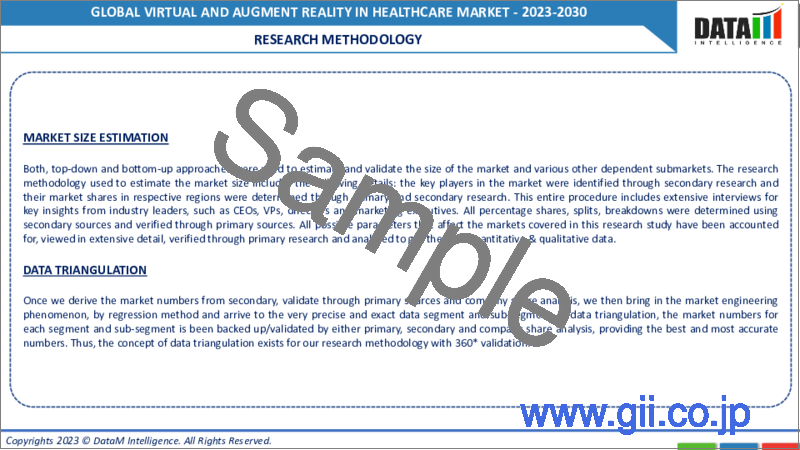|
|
市場調査レポート
商品コード
1352132
医療向け仮想現実・拡張現実の世界市場-2023年~2030年Global Virtual and Augment Reality in Healthcare Market - 2023-2030 |
||||||
カスタマイズ可能
適宜更新あり
|
|||||||
| 医療向け仮想現実・拡張現実の世界市場-2023年~2030年 |
|
出版日: 2023年09月27日
発行: DataM Intelligence
ページ情報: 英文 195 Pages
納期: 即日から翌営業日
|
- 全表示
- 概要
- 目次
概要
医療向け仮想現実・拡張現実の市場動向は、技術の進歩とAIの活用の高まりにより、サービス開始の増加を示しています。360度VR体験では、ユーザーは周囲の環境と相互作用し、変化させることができます。具体的な現実の上に、インタラクティブなレイヤーが追加され、イベント広告のためのいくつかのチャンスが可能になります。
さらに、技術・アプリケーション・コンポーネントの利用可能性の上昇、市場におけるソフトウェア数の増加、研究開発の増加により、医療向け仮想現実・拡張現実のための製品の採用が増加していることが、医療向け仮想現実・拡張現実の市場規模を押し上げています。
同市場は、この分野における進歩の高まりの結果、北米地域の製品に対する需要が伸びています。Real Response社、Microsoft社、Laerdal Medical社、Koninklijke Philips N.V.社などの競合企業が積極的に市場に参入しています。
ダイナミクス
シミュレーション・トレーニングへの仮想現実 (VR) の採用増加が医療向け仮想現実・拡張現実市場の成長を促進
AR/VR技術の利用は医療業界で大きく成長しています。VRシミュレーションの使用により、外科医は事前に手術を計画し、患者を危険にさらす可能性のある状況を予測し、侵襲性の低い治療を頻繁に行うことができます。さらに、遠隔医療サービスや心的外傷後ストレス障害の管理に、それぞれVRやARが利用されるようになり、画期的な進歩を遂げています。
観光とマーケティングでは、QRコードをスキャンしてより多くのコンテンツやメディアにアクセスできるAR技術の利用が伸びています。これらのコードは現在、パンフレットや広告、芸術作品の端に表示されています。前述のような主張の結果、市場は予測期間を通じて主導権を握ると予測されます。
医療におけるVRの進歩と用途の拡大が市場の成長機会を生み出す
VRを利用した新しい活用領域を発見するために、研究者によって幾つかの研究が行われています。2023年6月22日、ImmersiveTouch社の最先端手術計画技術は、患者の解剖学的構造のARとVRの3Dモデルを生成し、視覚化の改善、個別化された手術ソリューション、患者コミュニケーションの強化を実現するもので、ニューヨーク州のノースウェル・レノックス・ヒル病院が初めて使用しました。
FDA承認のこのシステムは、CTやMRI画像などの一般的な画像ファイルをインポートして、患者の解剖学的構造のバーチャル3Dモデルを即座に作成します。このような開発により、パーソナライズされたデジタル設計図、手術ガイダンス、再建用ハードウェアの作成が効率化され、術前準備から手術までの間隔が短縮されます。このような調査と進歩は、医療向け仮想現実・拡張現実の成長につながると思われます。
医療向け仮想現実・拡張現実に関する技術的限界が市場成長の妨げになる
医療向け仮想現実・拡張現実にはいくつかの課題が関連しており、その1つが技術的限界です。幅広い使用事例をカバーするこの大きなカテゴリーへの回答は、これを反映しています。VR機器の大きさが、特定の医療の文脈での使用を妨げる人もいるかもしれません。また、ポケットサイズのPCでは、モバイルVRプラットフォームを通じての没入感は限られると感じる人もいると思われます。
また、医療センターによっては、デバイスの解像度やコンピュータの制約による制限に直面する場合もあります。VRARAデジタルヘルス委員会のメンバーは、これらの問題に対する短期的な解決策を開発しています。ムーアの法則と市場競争の結果、この分野でも時間とともにサイズとパワーの両方が進歩すると確信しています。
目次
第1章 調査手法と調査範囲
第2章 定義と概要
第3章 エグゼクティブサマリー
第4章 市場力学
- 影響要因
- 促進要因
- シミュレーション・トレーニングにおける仮想現実 (VR) の採用増加
- 新製品発表の増加
- 抑制要因
- 医療向け仮想現実・拡張現実に関する技術的限界
- 機会
- 医療におけるVRの進歩と用途の拡大
- 影響分析
- 促進要因
第5章 産業分析
- ポーターのファイブフォース分析
- サプライチェーン分析
- 価格分析
- 規制分析
第6章 COVID-19分析
第7章 コンポーネント別
- ソフトウェア
- ハードウェア
- サービス別
第8章 テクノロジー別
- 拡張現実 (AR)
- 仮想現実 (VR)
- 複合現実 (MR)
第9章 用途別
- 患者ケア管理
- 医療トレーニング・教育
- フィットネス
- その他
第10章 エンドユーザー別
- 病院
- 診断センター
- 外来手術センター
第11章 地域別
- 北米
- 米国
- カナダ
- メキシコ
- 欧州
- ドイツ
- 英国
- フランス
- スペイン
- イタリア
- その他欧州
- 南米
- ブラジル
- アルゼンチン
- その他南米
- アジア太平洋
- 中国
- インド
- 日本
- オーストラリア
- その他アジア太平洋
- 中東・アフリカ
第12章 競合情勢
- 競合シナリオ
- 市況/シェア分析
- M&A分析
第13章 企業プロファイル
- Real Response
- 企業概要
- 製品ポートフォリオと説明
- 財務概要
- 主な動向
- Microsoft
- Laerdal Medical
- CAE Healthcare Inc.
- GE HealthCare
- Koninklijke Philips N.V.
- Fundamental Surgery
- ImmersiveTouch, Inc.
- PrecisionOS
- Atheer, Inc
第14章 付録
Overview
The virtual and augment reality in healthcare market trends show rising services launches owing to the rising technological advancements and usage of AI. In a 360-degree virtual reality experience, users can interact with and alter their surroundings. Over concrete reality, it adds an interactive layer that enables several chances for event advertising.
Furthermore, rising adoption of products for virtual and augment reality in healthcare due to the rising availability of technology, application and component and increase in the number of software in the market, and an increase in the research and development is driving up the virtual and augment reality in healthcare market size.
The market is experiencing a growth demand for products from North American areas as a result of the rising advancements in this field. With significant competitors like Real Response, Microsoft, Laerdal Medical, and Koninklijke Philips N.V. actively operating in the market.
Dynamics
Increasing adoption of Virtual Reality for Simulation Training Drive the Growth of the Virtual and Augment Reality in Healthcare Market
The use of AR/VR technologies has grown significantly in the healthcare industry. With the use of VR simulation, surgeons may plan operations in advance, anticipate situations that might endanger patients, and frequently do less invasive treatments. Additionally, breakthroughs have been made in the use of VR and AR for tele-health services and for the management of post-traumatic stress disorder, respectively.
Tourism and marketing have seen a growth in the usage of AR technologies, which allow users to scan a QR code to access more content or media. These codes are now present in brochures, advertisements, as well as on the edges of artworks. The market is predicted to take the lead throughout the forecast period as a consequence of the aforementioned claims.
Rising Advancements and Applications of VR in Healthcare Creates Opportunities for the Growth of the Market
Several researches are being conducted by researchers for discovering novel applications utilizing virtual reality. On June 22, 2023, the cutting-edge surgical planning technology from ImmersiveTouch, which generates augmented and virtual reality 3D models of patients' anatomies for improved visualization, personalized surgical solutions, and enhanced patient communication, is being used for the first time by Northwell Lenox Hill Hospital in New York State.
The FDA-approved system imports common imaging files, such as CT and MRI images, to instantly create a virtual 3D model of a patient's anatomy. These developments shorten the interval between preoperative preparation and surgery by streamlining the production of personalized digital blueprints, surgical guidance, and reconstructive hardware. These kind of research and advancements will lead to growth of virtual and augment reality in healthcare.
Technical limitations Associated with Virtual and Augment Reality in Healthcare will hamper the growth of the market
Several challenges are linked with the virtual and augment reality in healthcare one of them is technical limitations. Responses to this large category, which covers a wide range of use cases, reflect this. The size of VR devices may prevent some people from using them in specific healthcare contexts. Others may find that a pocket-sized PC can only offer so much immersion through mobile VR platforms.
Some medical centers may additionally face restrictions due to device resolution and computer constraints. Members of the VRARA Digital Health Committee are developing short-term solutions to these problems. We are certain that as a result of Moore's law and market competitiveness, both size and power will advance over time in this field as well.
Segment Analysis
The global virtual and augment reality in healthcare market is segmented based component, application, technology, end user and region.
Owing to High Demand, the Services from Component Segment Accounted for Approximately 57.7% of the Virtual and Augment Reality in Healthcare Market Share
The services category from components held the largest market share in 2022 and is expected to maintain its dominance over the forecast period due to a growth in surgical or medical simulation training worldwide, amongst the population. Numerous services are currently available in the market including medical or educational training for students , nurses or doctors specially on simulation training platform services. In order to provide students and healthcare providers with access to the virtual training.
For instance on March 7, 2023, an innovative virtual reality program for orthopedic training was announced by PrecisionOS, a top provider of medical education simulation. A comprehensive reference designed for all residency schemes in North America and abroad has been created by the company. The curriculum, developed with collaboration from several surgeon educators, is intended to improve the way surgical fellows are trained while also making it more current and supportive of skill development and milestones in surgical training.
Geographical Penetration
North America Accounted for Approximately 38.5% of the Market Share in 2022, Owing to the Strong Presence of Major Players and Increasing Healthcare Infrastructure Investment
Due to the rising need for virtual and augment reality in healthcare for knowledge purpose in healthcare, manufacturers in North America have chances of increasing their operations. There are many producers and suppliers in North America and owing to the quick economic growth of the region, industrial production has expanded, driving the demand for virtual and augment reality in healthcare for treatment.
Increasing expenditure on healthcare and rising adoption among end users, advancement of technologies for component or technology, and increase in pharmaceutical business establishment across the region are also contributing to the growth of virtual and augment reality in healthcare market share of this region.
It is also anticipated that the main healthcare organizations' and enterprises' collaborative research projects as well as new product development, which constantly seeks to improve available simulation training alternatives, will contribute to the expanding demand. Individuals are becoming more aware of various advanced products that are being utilized for providing better services, leading to the expansion of the market in this region. The above-mentioned factors further proves the dominance of North America on a global scale.
Competitive Landscape
The major global players in the virtual and augment reality in healthcare market include Real Response, Microsoft, Laerdal Medical, CAE Healthcare Inc., GE HealthCare, Koninklijke Philips N.V., Fundamental Surgery, ImmersiveTouch, Inc., PrecisionOS and Atheer, Inc among others.
COVID-19 Impact Analysis
Russia Ukraine Conflict Analysis
Due to the low prevalence as well as absence of major market participants in this region, it is predicted that the Russia-Ukraine conflict will not have a significant effect on the worldwide virtual and augment reality in healthcare market. The growth of the global virtual and augment reality in healthcare market, however, is anticipated to be relatively unaffected by the import and export of raw materials over the forecast period.
By Component
- Software
- Hardware
- Services
By Technology
- Augment Reality
- Virual Reality
- Mixed Reality
By Application
- Patient Care Mangement
- Medical Training and Education
- Fitness
- Others
By End User
- Hospitals
- Diagnostic Centers
- Ambulatory Surgical Centers
By Region
- North America
- U.S.
- Canada
- Mexico
- Europe
- Germany
- U.K.
- France
- Spain
- Italy
- Rest of Europe
- South America
- Brazil
- Argentina
- Rest of South America
- Asia-Pacific
- China
- India
- Japan
- Australia
- Rest of Asia-Pacific
- Middle East and Africa
Key Developments
- On January 19, 2023, the creation of vrClinicals for Nursing, a fully immersive virtual reality (VR) nursing training experience aimed at enhancing practice preparedness, was announced by Wolters Kluwer, Health, and Laerdal Medical. The National League for Nursing (NLN) created evidence-based scenarios for vrClinicals that imitate a genuine hospital setting and include demanding components like multiple patient scenarios and interruptions in order to better prepare students for providing high-quality patient care.
- On May 18, 2023, PrecisionOS is proud to announce the release of their new shoulder simulation module. PrecisionOS is an established supplier of virtual reality orthopedic surgery education. This instructional module, which is sponsored by CONMED, intends to inform students of the pertinent theories relating to rotator cuff restoration. Medical institutions can provide residents and fellows with the chance to learn arthroscopic double-row rotator cuff restoration in a realistic, risk-free setting with the help of this module.
- On January 17, 2020, in its first training solutions for Microsoft HoloLens 2, CAE Healthcare says it would incorporate holographic, model-based physiology in its patient simulators. By presenting 3D, interactive cardiac, circulatory and respiratory systems that help learners visualize human anatomy, mixed reality applications will speed up learning.
Why Purchase the Report?
- To visualize the global virtual and augment reality in healthcare market segmentation based on component, application, technology, end user and region as well as understand key commercial assets and players.
- Identify commercial opportunities by analyzing trends and co-development.
- Excel data sheet with numerous data points of virtual and augment reality in healthcare market-level with all segments.
- PDF report consists of a comprehensive analysis after exhaustive qualitative interviews and an in-depth study.
- Product mapping available as excel consisting of key products of all the major players.
The global virtual and augment reality in healthcare market report would provide approximately 53 tables, 54 figures and 195 Pages.
Target Audience 2023
- Manufacturers/ Buyers
- Industry Investors/Investment Bankers
- Research Professionals
- Emerging Companies
Table of Contents
1. Methodology and Scope
- 1.1. Research Methodology
- 1.2. Research Objective and Scope of the Report
2. Definition and Overview
3. Executive Summary
- 3.1. Snippet by Component
- 3.2. Snippet by Application
- 3.3. Snippet by Technology
- 3.4. Snippet by End User
- 3.5. Snippet by Region
4. Dynamics
- 4.1. Impacting Factors
- 4.1.1. Drivers
- 4.1.1.1. Increasing adoption of Virtual Reality for Simulation Training
- 4.1.1.2. Rising Novel Product Launches
- 4.1.2. Restraints
- 4.1.2.1. Technical limitations Associated with Virtual and Augment Reality in Healthcare
- 4.1.3. Opportunity
- 4.1.3.1. Rising Advancements and Applications of VR in Healthcare
- 4.1.4. Impact Analysis
- 4.1.1. Drivers
5. Industry Analysis
- 5.1. Porter's Five Forces Analysis
- 5.2. Supply Chain Analysis
- 5.3. Pricing Analysis
- 5.4. Regulatory Analysis
6. COVID-19 Analysis
- 6.1. Analysis of COVID-19
- 6.1.1. Scenario Before COVID-19
- 6.1.2. Scenario During COVID-19
- 6.1.3. Scenario Post COVID-19
- 6.2. Pricing Dynamics Amid COVID-19
- 6.3. Demand-Supply Spectrum
- 6.4. Government Initiatives Related to the Market During Pandemic
- 6.5. Manufacturers Strategic Initiatives
- 6.6. Conclusion
7. By Component
- 7.1. Introduction
- 7.1.1. Market Size Analysis and Y-o-Y Growth Analysis (%), By Component
- 7.1.2. Market Attractiveness Index, By Component
- 7.2. Software *
- 7.2.1. Introduction
- 7.2.2. Market Size Analysis and Y-o-Y Growth Analysis (%)
- 7.3. Hardware
- 7.4. Services
8. By Technology
- 8.1. Introduction
- 8.1.1. Market Size Analysis and Y-o-Y Growth Analysis (%), By Technology
- 8.1.2. Market Attractiveness Index, By Applicationl
- 8.2. Augment reality*
- 8.2.1. Introduction
- 8.2.2. Market Size Analysis and Y-o-Y Growth Analysis (%)
- 8.3. Virtual reality
- 8.4. Mixed Reality
9. By Application
- 9.1. Introduction
- 9.1.1. Market Size Analysis and Y-o-Y Growth Analysis (%), By Application
- 9.1.2. Market Attractiveness Index, By Application
- 9.2. Patient Care Mangement *
- 9.2.1. Introduction
- 9.2.2. Market Size Analysis and Y-o-Y Growth Analysis (%)
- 9.3. Medical Training and Education
- 9.4. Fitness
- 9.5. Others
10. By End User
- 10.1. Introduction
- 10.1.1. Market Size Analysis and Y-o-Y Growth Analysis (%), By End User
- 10.1.2. Market Attractiveness Index, By End User
- 10.2. Hospitals *
- 10.2.1. Introduction
- 10.2.2. Market Size Analysis and Y-o-Y Growth Analysis (%)
- 10.3. Diagnostic Centers
- 10.4. Ambulatory Surgical Centers
11. By Region
- 11.1. Introduction
- 11.1.1. Market Size Analysis and Y-o-Y Growth Analysis (%), By Region
- 11.1.2. Market Attractiveness Index, By Region
- 11.2. North America
- 11.2.1. Introduction
- 11.2.2. Key Region-Specific Dynamics
- 11.2.3. Market Size Analysis and Y-o-Y Growth Analysis (%), By Component
- 11.2.4. Market Size Analysis and Y-o-Y Growth Analysis (%), By Application
- 11.2.5. Market Size Analysis and Y-o-Y Growth Analysis (%), By Technology
- 11.2.6. Market Size Analysis and Y-o-Y Growth Analysis (%), By End User
- 11.2.7. Market Size Analysis and Y-o-Y Growth Analysis (%), By Country
- 11.2.7.1. U.S.
- 11.2.7.2. Canada
- 11.2.7.3. Mexico
- 11.3. Europe
- 11.3.1. Introduction
- 11.3.2. Key Region-Specific Dynamics
- 11.3.3. Market Size Analysis and Y-o-Y Growth Analysis (%), By Component
- 11.3.4. Market Size Analysis and Y-o-Y Growth Analysis (%), By Application
- 11.3.5. Market Size Analysis and Y-o-Y Growth Analysis (%), By Technology
- 11.3.6. Market Size Analysis and Y-o-Y Growth Analysis (%), By End User
- 11.3.7. Market Size Analysis and Y-o-Y Growth Analysis (%), By Country
- 11.3.7.1. Germany
- 11.3.7.2. U.K.
- 11.3.7.3. France
- 11.3.7.4. Spain
- 11.3.7.5. Italy
- 11.3.7.6. Rest of Europe
- 11.4. South America
- 11.4.1. Introduction
- 11.4.2. Key Region-Specific Dynamics
- 12.4.1. Market Size Analysis and Y-o-Y Growth Analysis (%), By Component
- 12.4.2. Market Size Analysis and Y-o-Y Growth Analysis (%), By Application
- 12.4.3. Market Size Analysis and Y-o-Y Growth Analysis (%), By Technology
- 12.4.4. Market Size Analysis and Y-o-Y Growth Analysis (%), By End User
- 12.4.5. Market Size Analysis and Y-o-Y Growth Analysis (%), By Country
- 12.4.5.1. Brazil
- 12.4.5.2. Argentina
- 12.4.5.3. Rest of South America
- 11.5. Asia-Pacific
- 11.5.1. Introduction
- 11.5.2. Key Region-Specific Dynamics
- 11.5.3. Market Size Analysis and Y-o-Y Growth Analysis (%), By Component
- 11.5.4. Market Size Analysis and Y-o-Y Growth Analysis (%), By Application
- 11.5.5. Market Size Analysis and Y-o-Y Growth Analysis (%), By Technology
- 11.5.6. Market Size Analysis and Y-o-Y Growth Analysis (%), By End User
- 11.5.7. Market Size Analysis and Y-o-Y Growth Analysis (%), By Country
- 11.5.7.1. China
- 11.5.7.2. India
- 11.5.7.3. Japan
- 11.5.7.4. Australia
- 11.5.7.5. Rest of Asia-Pacific
- 11.6. Middle East and Africa
- 11.6.1. Introduction
- 11.6.2. Key Region-Specific Dynamics
- 11.6.3. Market Size Analysis and Y-o-Y Growth Analysis (%), By Component
- 11.6.4. Market Size Analysis and Y-o-Y Growth Analysis (%), By Application
- 11.6.5. Market Size Analysis and Y-o-Y Growth Analysis (%), By Technology
- 11.6.6. Market Size Analysis and Y-o-Y Growth Analysis (%), By End User
12. Competitive Landscape
- 12.1. Competitive Scenario
- 12.2. Market Positioning/Share Analysis
- 12.3. Mergers and Acquisitions Analysis
13. Company Profiles
- 13.1. Real Response *
- 13.1.1. Company Overview
- 13.1.2. Product Portfolio and Description
- 13.1.3. Financial Overview
- 13.1.4. Key Developments
- 13.2. Microsoft
- 13.3. Laerdal Medical
- 13.4. CAE Healthcare Inc.
- 13.5. GE HealthCare
- 13.6. Koninklijke Philips N.V.
- 13.7. Fundamental Surgery
- 13.8. ImmersiveTouch, Inc.
- 13.9. PrecisionOS
- 13.10. Atheer, Inc
LIST NOT EXHAUSTIVE
14. Appendix
- 14.1. About Us and Services
- 14.2. Contact Us





